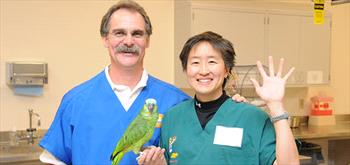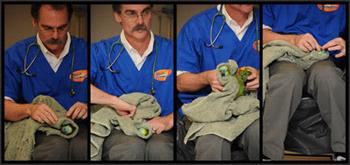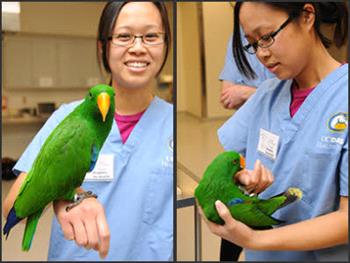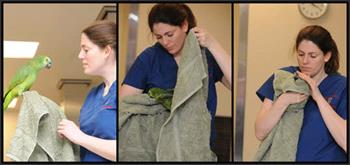Brian Speer is a Veterinarian, President and Director at the Medical Center for Birds in Oakley, California. He’s a Diplomate of the American Board of Veterinary Practitioners – Avian Practice and also a Diplomate of the European College of Zoological Medicine – Avian. The medical center caters exclusively to avian patients and has been caring for them in their quiet, bird-only atmosphere with rooms, diagnostic and surgical equipment suited especially to birds. Dr. Yin paid a visit to Dr. Speer at the Medical Center for Birds, and we had a chance to communicate with him in regards to this visit, and the practice.
What lead you to start an avian only practice?
After graduation from UCD in 1983, my intended goal was to enter mixed animal practice. After a couple years of that, however, I could clearly see that I was not happy being “Jack of all trades, master of none”, and I came to begin to understand that my passion was with birds. They offered considerable new opportunities for learning, demands for skillset development, and a vast need for scientific contributions to advancement of the species discipline. By 1989, I had limited my caseload to exclusively avian species, and was off on an incredible adventure! Since the sale of my concurrently managed small animal practice in 2004, the Medical Center for Birds has been in its own free-standing building, and now includes four full time veterinarians.
How did you become involved in the European College of Avian Medicine and Surgery?
After certifying in the American Board of Veterinary Practitioners in Avian practice in 1993, the newly formed European College of Avian Medicine and Surgery put out a call for defacto diplomates to join their college. Through a credentialing process, I was accepted as a member of ECAMS in 1989. ECAMS offered a much more evidence-based emphasis to the species discipline than did ABVP at the time, which was clinical practice oriented. The two, at least in my mind, allowed me to try to maintain balance professionally and in my career.
Most people have heard birds are sensitive to stress; can you expand on how birds handle stress and is it particularly important to use Low Stress Handling techniques with birds?
Not all bird species are equally sensitive to stress, but all are to varying degrees. The primary reasons for the use of low stress handling techniques and methods in avian species are no different than with companion dogs and cats. The adverse effects of learned fear, increased escape and avoidance behaviors, increased aggression, generalized fear and even apathy are profound. Ethically, we as healthcare professionals need to understand, recognize, avoid and mediate these common effects when they occur. Comparing the life expectancy of a dog or cat, measuring up to a maximum of two decades with the life expectancy of medium to large companion parrots (20–60 years or more) – the potential duration of these adverse effects of inappropriate and forceful handling and restraint methods that many companion birds can suffer is considerably longer.
Using towels when handling birds has been controversial, is there a right way and a wrong way to use a towel?
Absolutely. In very simple terms and methods, there are incredibly similar methods that Dr. Yin used and what we know can be used to shape a restraint experience for most companion birds.
Clients have said you use a ‘less is more’ approach, can you explain what they mean by this?
Less force, less coercion, less flooding, less fear – all lead to more avenues for participation in a restraint experience. There is an art and skill required to be able to comfortably use “less for more”, but this is absolutely the only way to go!
When people hear about training with counter-conditioning and desensitization, the biggest question that comes up is “Does that work for birds too?”. Do you find you can use training techniques like these with birds, and what advise would you give to people wanting to train their birds to be less fearful of handling?
The science of learning is uniform for all animals (and people). DS / CC methods are commonly applied with companion and aviary birds in our practice, and can
be highly effective. Simple basic advice to get folks started on the road to reduced fear of handling is:
- If what you are doing causes fear, stop it.
- Build and earn trust.
- Build and counter condition behaviors using positive reinforcements.
What is/are the most common question(s) you get in practice from pet bird owners and what is the answer?
Most questions are often about how to produce what we call “Dead Bird Behaviors”. How can I make my bird not bite? How can I make my bird not scream? How can I make my bird not feather pluck? etc. In reality, although we do not want to see those behaviors, the *magic* in helping the bird to choose to not do them is by teaching it something else to do that is acceptable to you and that provides an equal if not greater consequence than the undesired behavior. A consistent answer that we try to get across to veterinarians and clients is that the secret of success is often not by the punishment of the behaviors (alone), but by replacement of those problem behaviors with effective alternatives for the bird.
What advise would you give to people with birds already stressed out by vet visits to help them?
First up, if they see that their bird is being overpowered, frightened or injured, stop it. Discuss your desires and concerns with the veterinarian for less stressful restraint methods. Inquire about other options.
After Dr. Yin’s visit, Dr. Speer said: “These laboratories are wonderfully fun to teach, and very rewarding to see people’s minds beginning to open up about changing the status quo of forceful “Capture and Restraint” methods that sadly remain quite common in the world as a whole. But, what you can consistently see is that people are interacting with birds that are not showing overt fear, people and birds are for the most part relaxed, and you can see various flavors of the shaping of a restraint experience.”






